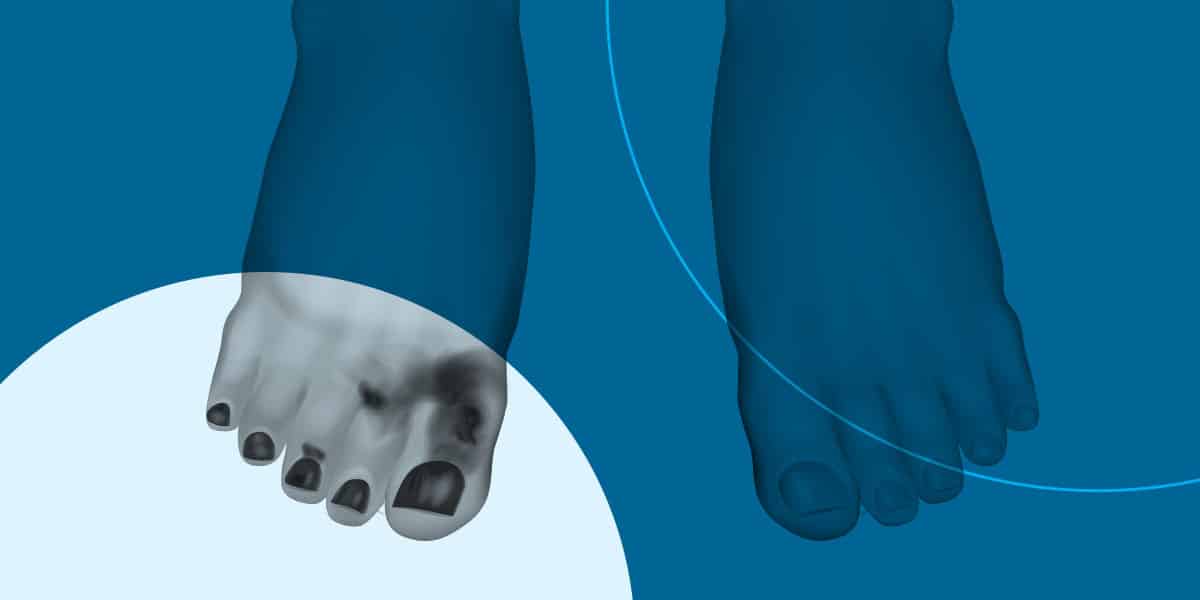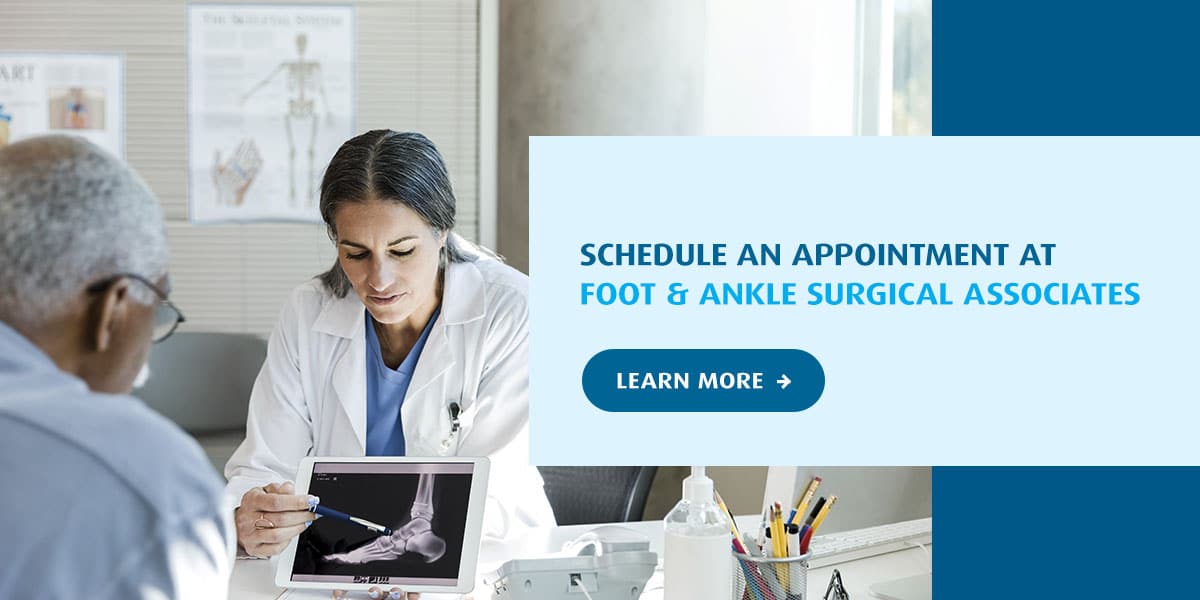
Have you noticed discoloration, texture changes and numbness in your feet? Are your feet cold to the touch? You might have early signs of a gangrene infection if you’ve checked all these boxes.
What is this condition, and what can you do to treat a gangrene foot infection? There are many ways to identify and treat gangrene before it becomes life-threatening. Review this guide to understand the types of gangrene, the risks of infection and how to manage and prevent this health problem.
What Is Gangrene?
Gangrene is dead body tissue caused by a restriction of blood supply or acute bacterial infection. It can affect various limbs, including feet, toes, arms and legs. Gangrene can also form in muscles and organs like your intestines and appendix. A gangrene infection can lead to side effects like skin discoloration, pain and numbness in limbs and, in severe cases, amputation.
Here are some causes of gangrene in the foot.
- Insufficient blood supply: When something interrupts your blood supply, your cells and body tissue become starved of oxygen and nutrients. Limited circulation can also lead to reduced antibodies, making it challenging for your body to fight off infection.
- Injury: Minor or severe accidents leading to foot injury and open wounds can cause bacterial infection. If this infection goes untreated, gangrene can develop.
- Infection: A buildup of bacteria like Clostridium Perfringens spores can lead to infection and spread if untreated.
Types of Gangrene
Here are two common types of gangrene.
- Dry gangrene often affects the hands and feet and is more common in people with diabetes, vascular disease and autoimmune diseases like arthritis. It can result from impaired or lack of circulation to various areas. You can identify dry gangrene by side effects like discolored, brown or purplish skin. This skin can decay and fall off. If dry gangrene goes untreated, it can develop into wet gangrene and spread through your body.
- Wet gangrene can result from traumatic injuries like burns, crushing accidents and gunshot wounds, which can cut off blood supply to cells and body tissue. You can identify wet gangrene by signs like an infection with swelling, blistering, drainage or unpleasant odors. This infection can spread through your body if untreated. Types of wet gangrene include gas gangrene and progressive bacterial synergistic gangrene.
Who Is Most Likely to Get a Gangrene Foot Infection?
The following health conditions and lifestyle decisions could elevate your gangrene risk.

- Diabetes: High blood sugar can often lead to damaged blood vessels, reducing blood supply to body areas like hands and feet.
- Peripheral artery disease: Blood vessel disease involves the buildup of fatty deposits on arteries, leading to poor circulation and gangrene.
- Reynaud’s disease: People with Reynaud’s disease can have restricted blood flow to various bodily areas due to extreme cold.
- Obesity: Extra body weight can strain arteries and lead to poor circulation to body tissue.
- Smoking: Smoking can result in blood vessel or peripheral artery disease, leading to constricted blood flow and poor circulation.
What Does Gangrene Look Like on Your Feet?
Gangrene in your foot can appear as discolored, brownish or purplish skin. You might have swelling, blisters and decaying tissue. Here are some common symptoms of a gangrene foot infection:
- Your foot looks blue, black, brown or purple
- Dry and withering discolored skin that can decay and fall off
- Cold skin
- Loss of feeling or numbness
- Foot swelling and blisters
- Unpleasant-smelling discharge from sores and blisters
- Severe pain in the infected area and surrounding foot
- Thin, shiny skin
- A noticeable difference between healthy and damaged skin
- Persistent fever
- Confusion and low blood pressure
- Septic shock
How Does Gangrene Start on the Foot?
Gangrene can gradually start in your foot with changing skin color, sores, coldness and numbness in the infected area. Some initial warning signs of gangrene in your foot can include:
- A distinct red line around the affected area
- Cuts, sores and redness
- Swelling and skin lacerations
- Dry and thin skin
- Purple, blue and black discoloration
- Los of sensation or numbness in the affected area
- Cold skin to the touch
Risks of a Gangrene Infection
Some complications or risks of getting a gangrene foot infection can include the following.
- Spreading: Untreated dry gangrene can become wet gangrene and spread to other body tissues and organs.
- Sepsis and septic shock: Germs from gangrene can migrate to other bodily areas, leading to inflammation known as sepsis.
- Amputation: If bacteria spread to other body areas and tissue, amputation can be necessary to remove the infection.
- Scarring: Surgically removing infected tissue can lead to scarring, requiring reconstructive surgery.
When to See a Doctor
Gangrene is a severe and life-threatening medical emergency requiring rapid treatment. You should see your doctor immediately if you experience symptoms like:
- Unexplained and consistent pain in your foot
- Skin texture and color changes
- Ongoing fever
- Cold, stiff, numb and pale skin
- Persistent sores or cracks with foul-smelling discharge
Treatment Options for Gangrene
Treatment options for gangrene in your foot include restoring blood flow and treating and removing infected tissue.
Lumivascular Atherectomy
Lumivascular atherectomy is an advanced and minimally invasive surgery. Your surgeon will use a tiny camera to see inside your artery, safely and accurately identifying and removing infected tissue. Plaque and damaged tissue removal can restore blood supply to body tissue, improve circulation and help you avoid amputation. Lumivascular atherectomy can be an effective option for unblocking arteries.
Antibiotics
Doctors can prescribe antibiotics through an intravenous drip to treat gangrene infections.
Maggot Therapy
Doctors can use lab-bred and sterile maggots to remove dead body tissue and prevent infection from spreading. During the procedure, maggots on the wound eat away the dead tissue without compromising healthy cells and tissue. These surgical maggots also release chemicals that fight bacteria and enhance healing.
Amputation
In severe cases, a surgeon may recommend debridement or amputation to prevent the spread of infection. This procedure includes surgically removing dead tissue or a limb like your foot or toe.
How Can You Prevent a Gangrene Foot Infection?
You can prevent a gangrene foot infection in the following ways.
- Manage your diabetes: If you have diabetes, you must monitor and control your blood sugar to reduce the risk of blood vessel damage and poor circulation.
- Manage your weight: Maintain a healthy weight and prevent straining your arteries and affecting blood flow.
- Avoid smoking: Reduce damage to blood vessels by not smoking, especially if you have diabetes or peripheral artery disease.
- Protect your feet: Avoid foot injuries, including scratches, cuts and other wounds. If you get wounds, keep them clean and covered to prevent bacterial infection.
- Get professional foot examinations and treatment: Frequently check your feet for cuts, wounds, sores and skin issues and seek immediate professional attention to prevent gangrene from developing.
Schedule an Appointment at Foot & Ankle Surgical Associates
Early detection of foot cuts, sores, pain and skin issues can prevent gangrene growth and spread. Improper management can lead to severe side effects like septic shock and amputation.
At Foot & Ankle Surgical Associates, we know the importance of caring for your feet to prevent gangrene. Our team of surgeons are experts in their field and can detect early signs of gangrene before it spreads. We offer advanced technology to minimize and reverse gangrene and restore healthy blood flow and circulation to infected areas. You can avoid invasive solutions and improve your quality of life.
Contact us online or call 360-754-3338 for a consultation.





